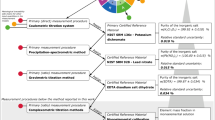Abstract
Research and development activities are on in many laboratories to develop methods for detecting energetic materials at the trace level. Production or application of high-energy materials may also contaminate the natural environmental systems. Therefore, development of a simple, portable, and inexpensive device for determining explosives at the trace levels is highly desirable. In this study, a stripping voltammetry technique is used for their analytical determination. The study is conducted in an acetonitrile medium. Optimum conditions are obtained in stripping voltammetry for individual analytes. The stripping voltammetric method is compound-selective and can be used for determining a particular high-energy material in a mixture. In this paper, we report the development of an electro-analytical procedure for detecting conventional energetic materials such as Tetryl, TNT, PETN, RDX, and HMX, using the stripping voltammetric method.
Similar content being viewed by others
References
J. E. Walker and D. L. Kaplan, “Biological degradation of explosives and chemical agents,” Biodegradation, 3, 369–385 (1992).
A. K. Hilmi, J. H. T. Luong, and A. L. Nguyen, “Development of electrokinetic capillary electrophoresis equipped with amperometric detection for analysis of explosive compounds,” Anal. Chem., 71, No. 4, 873–878 (1999).
J. Reynolds, P. Nunes, R. Whipple, and A. Alcaraz, “On-site analysis of explosives in various matrices, detection and disposal of improvised explosives,” NATO, Security through Sci. Ser., 27–32 (2006).
D. Gaurav, A. K. Malik, and P. K. Rai, “Highperformance liquid chromatographic methods for the analysis of explosives,” Crit. Rev. Anal. Chem., 37, No. 4, 227–268 (2007).
B. R. McCord and E. C. Bender, “Chromatography of Explosives,” in: A. Beverage (ed.), Forensic Investigation of Explosives, Taylor and Francis, London (1998), pp. 231–235.
S. E. Klassen, P. Rodacy, and R. K. Silva, “Reactant ion chemistry for detection of TNT, RDX, and PETN using an ion mobility spectrometer,” Sandia National Laboratories Report No. SAND97-2165 (1997).
S. Desilets, L. V. Haley, and U. Thekkadath, “Trace explosives detection for finding landmines,” in: A. C. Dubey, J. F. Harvey, and J. Broach (eds.), Detection and Remediation Technologies for Mines and Minelike Targets III, Int. Soc. for Opt. Engineering, Seattle (1998), pp. 441–452.
S. P. Panda, S. G. Kulkarni, S. K. Sahu, V. N. Bhoraskar, and P. A. Dokhale, “Fast neutron activation analysis of high energy materials and polymers,” J. Energ. Mater., 16, No. 4, 309–341 (1998).
T. Chow, J. Liu, M. Piwoni, and R. N. Adrian, “Analysis of the transformation of nitroaromatic compounds in waste water by bacteria using Micellar electrokinetic capillary chromatography,” J. Capillary Electrophor., 4, No. 4, 189–194 (1997).
S. J. Morgan, A. W. Bryden, A. J. Miragliotta, and C. L. Aamodt, “Improved detection of explosive residues by laser thermal desorption,” John Hopkins Appl. Tech. Digest, 20, No. 3, 389–935 (1999).
J. Asplund, “Differential pulse polarographic analysis of powders and explosives,” J. Propellants Explos. Pyrotech., 11, No. 3, 69–80 (1986).
P. Janderka, O. Fischer, and E. Fischerova, “Effect of the solvent basicity and additives on the electroreduction of picric acid and tetramethylammonium picrate in aprotic media,” Collect. Czech. Chem. Commun., 62, No. 4, 581–596 (1997).
Y. Aimin and C. Hongyuan, “Electrocatalytic oxidation of hydrazine at the polyglutamic acid chemically modified electrode and its amperometric determination,” Anal. Lett., 30, No. 3, 599–607 (1997).
R. Perezolmos, A. Rios, P. M. Martin, A. S. R. Lapa, and L. F. C. J. Lima, “Construction and evaluation of ion selective electrodes for perchlorate with a summing operational amplifier: Application to pyrotechnics mixtures analysis,” Analyst, 124, No. 1, 97–100 (1999).
C. D. Gwenin, M. Kalaji, C. M. Kay, P. A. Williams, and D. N. Tito, “An in situ amperometric biosensor for the detection of vapours from explosive compounds,” Analyst, 133, No. 5, 621–625 (2007).
J. Wang, S. Thongngamdee, and A. Kumar, “Highly stable voltammetric detection of nitroaromatic explosives in the presence of organic surfactants at a polyphenolcoated carbon electrode,” Electroanalysis, 16, No 15, 1232–1235 (2004).
J. G. E. Gardeniers and A. Van Den Berg, “Lab-on-achip systems for biomedical and environmental monitoring,” Anal. Bioanal. Chem., 378, No. 7, 1700–1703 (2004).
J. Wang and S. Thongngamdee, “On-line electrochemical monitoring of (TNT) 2,4,6-trinitrotoluene in natural waters,” Anal. Chim. Acta, 485, No. 2, 139–144 (2003).
J. Wang, S. B. Hocevar, and B. Ogorevc, “Carbon nanotube-modified glassy carbon electrode for adsorptive stripping voltammetric detection of ultra trace levels of 2,4,6-trinitrotoluene,” Electrochem. Commun., 6, No. 2, 176–179 (2004).
Author information
Authors and Affiliations
Corresponding author
Additional information
__________
Translated from Fizika Goreniya i Vzryva, Vol. 47, No. 1, pp. 99–107, January–February, 2011.
Rights and permissions
About this article
Cite this article
Prabu, H.G., Talawar, M.B., Mukundan, T. et al. Studies on the utilization of stripping voltammetry technique in the detection of high-energy materials. Combust Explos Shock Waves 47, 87–95 (2011). https://doi.org/10.1134/S0010508211010126
Received:
Published:
Issue Date:
DOI: https://doi.org/10.1134/S0010508211010126




